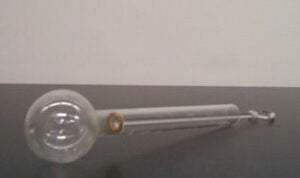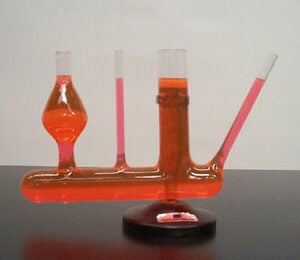F.2(1) – Glass Pressure Syringe
This apparatus illustrates that pressure is transmitted equally in all directions. It is a long necked flask with the neck accommodating a piston. The glass bulb has a 5 cm diameter and small holes perforated along the circumference. Fill the flask with water and set the piston in place. Hold the syringe so that the plane of the holes is horizontal and apply pressure to the piston. Water will squirt out the same distance from each hole.

F.2(2) – Water Pressure
A larger beaker is filled with water. A plastic cylindrical vase with a hole in the bottom and a plate a little larger than the vase’s diameter are provided. Hold the plate against the vase’s rim and submerge it. Water pressure will hold the plate in this position even if you let go of it. Pour water into the vase until the inside water level equals the outside. The plate will fall as the pressure on both sides of it are equated. This happens independently of the vase’s shape.

F.2(3) – Constant Level Tubes
The apparatus consists of four glass tubes of various shapes manifolded together. The container is half-filled with water. A dye is used to color the water to aid visibility at a distance. It shows that a liquid in connecting vessels of different shapes stands at the same level.’
